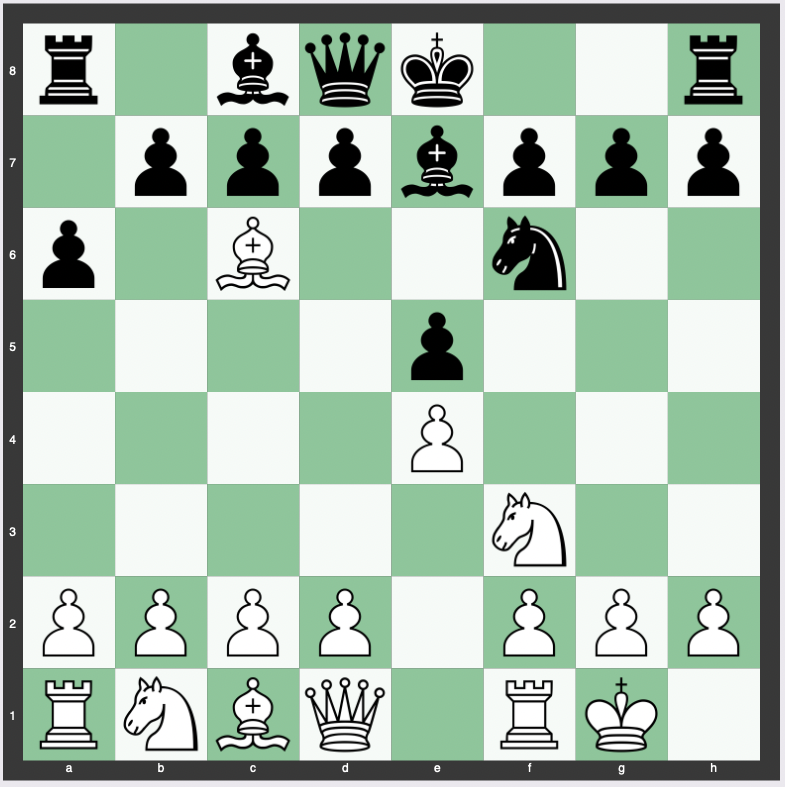The Delayed Exchange Variation Deferred is a fascinating and intricate chess opening that falls under the umbrella of the Ruy Lopez opening.
It’s a line that has been explored by many top players and continues to be a subject of deep analysis.
Below we look into the various aspects of this opening, from its move order to its historical significance.
Move Order of the Delayed Exchange Variation Deferred
- e4 e5
- Nf3 Nc6
- Bb5 a6
- Ba4 Nf6
- O-O Be7
- Bxc6

The move order of the Delayed Exchange Variation Deferred is a sequence of well-coordinated steps that lead to a specific position on the chessboard.
Each move is carefully chosen to create opportunities and challenges for both players.
Theory, Strategy, and Purpose of the Delayed Exchange Variation Deferred
The Delayed Exchange Variation Deferred is rich in strategic complexity.
The purpose of this opening is to create an imbalance in the position, allowing for dynamic play.
By exchanging the bishop for the knight on move 6, White aims to damage Black’s pawn structure and gain a positional advantage.
Though bishops are generally more valuable than knights, if it involves doubling the opponent’s pawns that can be a long-term weakness for them.
The underlying theory of this opening is deeply rooted in understanding pawn structures, piece activity, and long-term planning.
Variations of the Delayed Exchange Variation Deferred
There are several variations within the Delayed Exchange Variation Deferred that can lead to different types of positions.
Depending on the subsequent moves, the game can transition into tactical or positional battles.
Some variations favor aggressive play, while others are more conservative.
Understanding these variations is essential for players who wish to specialize in this opening.
The best reply for black is to take the bishop with the d pawn. It gives black a roughly even position.
Continuation Lines in the Delayed Exchange Variation Deferred
Some sample continuation lines include:
6… dxc6 7. d3 Bg4 8. h3 Bh5 9. Be3 Qd6 10. Nbd2 Nd7 11. a4 O-O-O 12. b4 Qxb4 13. Nc4 f6 14. a5 g5 15. Rb1 Qa4 16. Ra1
6… dxc6 7. d3 Nd7 8. Nc3 O-O 9. a4 b6 10. Be3 Re8 11. Nd2 Nf8 12. Qh5 Ng6 13. g3 Bb4 14. f4 exf4 15. gxf4 f5 16. Nf3 Be6
6… dxc6 7. d3 Nd7 8. Nc3 O-O 9. a4 b6 10. Be3 Re8 11. h3 a5 12. Kh1 Bd6 13. Nd2 Nf8 14. f4 exf4 15. Bxf4 Bxf4 16. Rxf4 Qd6 17. Ne2 Ba6 18. Rf5 Rad8 19. b3 Ng6 20. Qe1 Qb4 21. Ng3
6… dxc6 7. d3 Nd7 8. Nc3 O-O 9. a4 Re8 10. Be3 b6 11. Kh1 c5 12. h3 Rb8 13. Qe2 Bd6 14. Nd2 Nf8 15. Nc4 Ng6 16. Nxd6 cxd6 17. f4 exf4 18. Bxf4 Nxf4 19. Rxf4 Be6 20. Raf1 h6 21. Qf2 b5
History of the Delayed Exchange Variation Deferred
The history of the Delayed Exchange Variation Deferred is intertwined with the broader history of the Ruy Lopez.
Named after the 16th-century Spanish priest Ruy López de Segura, this opening has been a part of chess literature for centuries.
The Delayed Exchange Variation Deferred itself has been explored by many Grandmasters and continues to evolve with modern chess theory.
Is the Delayed Exchange Variation Deferred Good for Beginners or Intermediates?
The Delayed Exchange Variation Deferred is considered to be more suitable for intermediate and advanced players.
Its complexity and the understanding required for the underlying strategies make it a challenging choice for beginners.
However, studying this opening can provide valuable insights into chess principles and strategic thinking.
How Often Is the Delayed Exchange Variation Deferred Played at the Grandmaster Level?
At the Grandmaster level, the Delayed Exchange Variation Deferred is played with moderate frequency.
It’s not as popular as some other mainline openings, but it has been employed by top players in important matches.
Its unique characteristics make it a valuable weapon in a Grandmaster’s opening repertoire, especially when looking for unbalanced positions.
Ruy López Opening: Morphy Defense, Delayed Exchange Variation, 1-0
Conclusion
The Delayed Exchange Variation Deferred in the Ruy Lopez is a captivating and complex opening that offers a rich array of strategic and tactical possibilities.
From its precise move order to its historical significance, it’s an opening that continues to intrigue and challenge players at all levels.
Whether you’re an intermediate player looking to expand your opening knowledge or a chess enthusiast interested in the deeper intricacies of the game, the Delayed Exchange Variation Deferred provides a fascinating avenue for exploration and growth.


